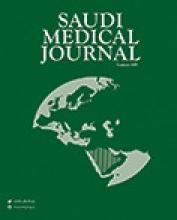Abstract
OBJECTIVE: To review all cases of cesarean section in the primigravid mother delivered at the Riyadh Armed Forces Hospital between January 1996 and December 1997. To determine its incidence, describe the clinical indications, outcome and highlight areas of improvement in an attempt to reduce the rate of cesarean section.
METHODS: Retrospective case record analysis.
RESULTS: During the study period there were 15301 deliveries. The overall cesarean section rate for 1996 was 12% and for 1997 was 13%. The rate of cesarean section in the primigravid was 12%. The rate of cesarean section in primiparas breech was 41%. Cesarean section in the unbooked primiparas was 15% as compared to 12% in the booked ones. Fetal distress with or without failure of progress was the main indication for cesarean section in singleton cephalic presentations. In breech presentations, cesarean section was carried out as an elective procedure in 45% and fetal distress was the indication in 21% of cases. Fetal distress was the main indication in twins.
CONCLUSION: The rate of cesarean section in the primiparas was similar to the rate of cesarean section in the obstetric population. The rate of cesarean section in the primiparas breech was slightly higher than cesarean section in the multiparas breech. Fetal distress was the leading indication for cesarean section in twins and those with cephalic presentation. The rate of cesarean section can be safely reduced by reviewing and auditing the primary indication for cesarean section, the Consultants doing frequent rounds on delivery suites and being involved directly in cesarean section decision, careful interpretation of fetal monitoring and allowing more patients with breech presentation to have vaginal delivery under close observation.
- Copyright: © Saudi Medical Journal
This is an open-access article distributed under the terms of the Creative Commons Attribution-Noncommercial-Share Alike 3.0 Unported, which permits unrestricted use, distribution, and reproduction in any medium, provided the original work is properly cited.






